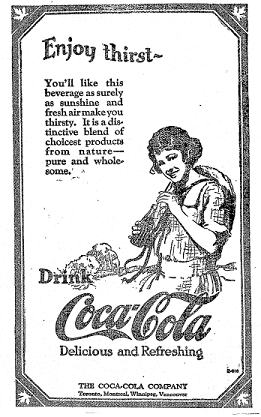
Word of the Day: Sodality
Paul Schleifer
According to the OED, sodality is a noun meaning “a confraternity or association, especially a Roman Catholic religious guild or brotherhood.” It appears in English in the early 17th century, coming from the French sodalité or from Latin sodalitas, from sodalis “comrade.” www.etymonline.com adds, “perhaps literally ‘one’s own, relative,’ related to suescere ‘to accustom,’ from PIE *swedh-, extended form of root *s(w)e-, pronoun of the third person and reflexive.”
Sodality, by the way, has nothing to do with soda, which is a short version of “sodium carbonate,” but which does lead us into what is special about May 8.
On this date in 1886, John Pemberton, a pharmacist who liked to invent medicines, sold the first Coca-Cola, a drink which contained cocaine as well as caffeine from the kola nut. The name was coined by Pemberton’s bookkeeper, a guy named Frank Robinson, but don’t try to look him up on Google because you’ll have to work your way through all the hits for the great Baltimore Orioles’ outfielder.
Pemberton teamed up with another Atlanta pharmacist named Asa Candler, and the company took off. In the last decade of the 19th century, sales of Coca-Cola went from a million servings in 1890 to 100 million in 1900. They began selling the syrup to independent bottling companies who were licensed to sell the drink around the nation and in Canada.
For decades the connection between Coca-Cola and other soda or pop drinks and pharmacies stayed strong. Drug stores frequently had a “soda fountain” in their stores, operated by “soda jerks” (so-called because this clerk jerked the handle of the soda dispenser on and off).
Several years ago, my son had to read a book over the summer for his honors world history class; it was A History of the World in 6 Glasses by Tom Standage (Bloomsbury, 2009). The basic premise is that world history can be looked at through drinks that were discovered and then dominated the world (other than water, which is somewhat dangerous to drink in many parts of the world). The six drinks are
Beer, which dominated in the earliest period of human history;
Wine, which dominated in the Greek and Roman periods;
Rum, or spirits, which dominated in the colonial period;
Coffee, which inaugurated the Age of Reason (and no wonder, since suddenly people had a drink which didn’t give them an all-day buzz);
Tea, which helped to create the largest empire in the history of the world;
And finally, Coca-Cola, which travelled around the world with American soldiers during World War II.
There is a sense in which the Great American Pax coincided with the global distribution of Coca-Cola, and it may be that the decline of soda drinking (due to health concerns and the advent of bottled water) will coincide with the decline of world domination by American culture, though that has yet to be determined.
Of course, one big difference between the Coca-Cola that dominated the world starting with the Second World War and the Coca-Cola invented by John Pemberton is the cocaine, which one can no longer find in the drink. Maybe we should allow the company to reintroduce the cocaine into the beverage; maybe doing so would lead to world-wide sodality.
The image is a Coca-Cola advertisement from 1924.